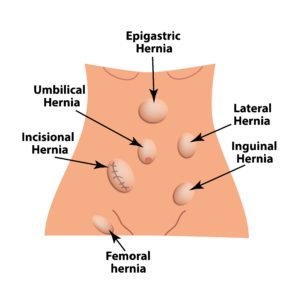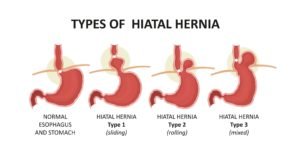Hernia Repair
A hernia can cause serious pain and physical problems, but it can be repaired surgically. The Association of South Bay Surgeons has surgeons who repair hernias on an outpatient basis, using advanced techniques that require only very small incisions.
Hernia Repair Q & A
Inguinal hernias are by far the most common type of hernia. This kind of hernia occurs in the groin area, and typically happens when a sac of peritoneum (abdominal cavity lining) protrudes through an opening in the muscle wall in the lower abdomen. A portion of the intestine can get trapped and strangled, which requires emergency surgery. There are other types of hernias, including femoral, umbilical, incisional, epigastric, and hiatal hernias.
The exact cause of hernias hasn’t been definitively established. However, certain things are known to enlarge a hernia once it’s already there. These things can include strenuous physical activity, straining, and coughing deeply.
Surgical repair is the only effective way to treat an inguinal hernia. Thus, surgical correction is the recommended course of action for nearly all people suffering from an inguinal hernia.
Hernia surgery can be done in 2 ways, either in the traditional way with open surgery or with a newer laparoscopic technique. In the older method, the doctor creates a 3-4 inch incision directly over the hernia. The sac of peritoneum is then either surgically removed or moved back into the abdominal cavity with a mesh patch placed on top the weakened area. Open surgery takes around 25-30 minutes and is performed while the patient is under general anesthesia. In laparoscopic hernia surgery, 3-4 tiny incisions, generally less than .5 inches long, are created in the hernia area. Carbon dioxide is then delivered to the abdomen through small tubes. This expands the abdomen so the surgeon clearly sees the hernia via a tiny camera inserted through the small incision. Surgical instruments move through the incisions to allow the surgeon to pull the hernia away from the muscle and place a plastic mesh patch for stability. As with open surgery, laparoscopic surgery takes around 25-30 minutes and is performed while the patient is under general anesthesia.
Patients usually return home 2-3 hours after laparoscopic hernia surgery, while open hernia surgery may require a hospital stay of at least 1 night. Patients who have laparoscopic hernia surgery usually resume full physical activity after 1-2 weeks, while open hernia surgery patients need at least a month for recovery.





Leave a Reply